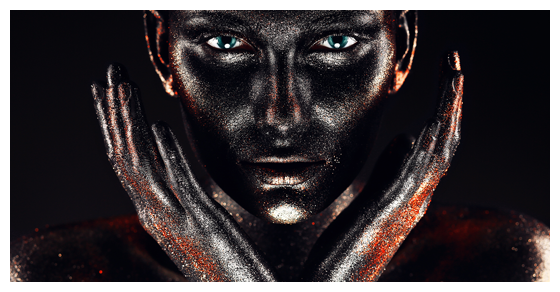
Resisting Surveillance Through Art
With growing concern about proliferating surveillance, a number of artists have created fashionable ways to hide from the camera’s gaze. These include designs such as irregular face paint and hairstyles, creepy-looking masks, and reflective underwear. The problem with such symbolic plays of avoidance is that they fail to challenge discriminatory uses of surveillance.
Artistic forms of resistance are increasingly popular among scholars studying surveillance. In my recent article in Communication and Critical/Cultural Studies, I ask what it means that such designs focus on an individual’s ability to hide in plain sight. What gets left out of that framing? How might resistance be more effective for more people?
Adam Harvey’s CV Dazzle project epitomizes anti-surveillance camouflage. Through the use of jarring asymmetrical lines in face makeup and hairstyles, his vibrant creations confound face-recognition systems, rendering them ineffective at identifying people in public. The designs are intended to be overt fashion statements as well, the representations of which circulate widely, hopefully sparking a debate about the prevalence of surveillance in society.
The discursive framing of such work matters because it shapes collective definitions of the problem and the issues at stake. In this case, CV Dazzle mobilizes an evolutionary narrative to justify camouflage, saying that just like in “the animal kingdom,” people must invent forms of deception to survive. The unspoken implication is that if people don’t adapt they will become prey, and perhaps they deserve this fate.
I argue that playing with illegibility may allow one to flirt with the idea of deviance, but one cannot ever completely escape the identities ascribed by institutions. Pretending to do so postpones a much-needed conversation about the ways in which experiences of surveillance differ radically based on one’s social address and physical characteristics. By attending to the poses of privileged white bodies adorned with tribal-themed face paint, we may lose an opportunity to critique the ways that surveillance reproduces inequalities and marks people of color as threatening.
A different artistic project by Leo Selvaggio relies on the manufacture and circulation of lifelike resin masks of his face. These masks are intended to fool face recognition software—like that used by Facebook—into wrongly identifying the masked person as Selvaggio. If worn by many people, they also have the ability to spawn swarms of expressionless doppelgangers moving along city streets. The project, called URME, aspires to force recognition of the ways being monitored might negatively constrain one’s autonomy or identity. Selvaggio says, “When we are watched we are fundamentally changed. We perform rather than be.”
As with CV Dazzle, the URME masking project regards invasive surveillance as inevitable. The goal, therefore, is to find innovative ways to maintain privacy in spite of it, not to challenge it directly. But by suggesting that people have pure or true identities that are somehow corrupted by surveillance, the project doesn’t acknowledge the ways that individuals always craft presentations of themselves for others. A deeper question might be to ask how surveillance shapes identities and experiences in largely invisible ways, especially as decisions increasingly are delegated to computer algorithms that sort populations unequally based on perceived value or risk.
Another set of artistic examples involves designs to empower women to evade harassment or attack. As part of the Anti/Surveillance Fashion Show held in 2010, artists from the Noisebridge hackerspace staged a lively presentation of clothing and devices to assist with resistance efforts. A number of these designs were oriented toward the protection of women in public. For instance, there were women’s shoes embedded with a “panic alarm” that could be triggered when the wearer felt she was in danger. There was also a hoodie adorned with mirrors that would allow women to detect assailants sneaking up behind them. Finally, there was a “crotch dazzler” (reflective underwear) that would blind any camera photographs. The device was presented as a perfect solution to the problem of surreptitious upskirt photographs of women or girls.
These Noisebridge designs act as non-confrontational technological fixes to the problem of gendered violence. Unfortunately, they offer severely limited forms of protection or empowerment. The assumption is that it is women’s responsibility to anticipate dangers and protect themselves by purchasing anti-surveillance clothing and devices. The designs therefore normalize public surveillance and violence against women by accepting these things as background conditions.
The anti-surveillance artworks reviewed in my article allow people to hide from automated surveillance systems. They introduce an interesting paradox: hiding becomes a form of artistic expression, whereas uniqueness is cultivated by obscuring identity markers. While the projects may be enticing and fun, on the whole they don’t compel people to confront the legitimacy of public surveillance, the unequal application of such systems, or the root causes of discrimination and violence.
More effective forms of resistance would start by recognizing privilege and acknowledging that there is no universal “we” subjected to surveillance. It would be valuable to explore mechanisms of “marginalizing surveillance,” which produce conditions and identities of marginality through their very application. Some of these applications include heightened police monitoring of urban youth, tracking and controlling the purchases of welfare recipients, and routine drug testing of employees in precarious service-sector jobs.
Additionally, alternative resistance efforts would make mainstream institutions more transparent and catalyze collective action against conditions of abuse. The work of Wikileaks may be the most well-known transparency project, but there are many possibilities to deploy surveillance techniques in the service of social and environmental justice. For instance, these could include collecting and circulating data on people killed by police, drone attacks, or environmental dangers. Whatever the approach, it is vital that artists take seriously race and gender differences and ask whether their creations may do more harm than good.

